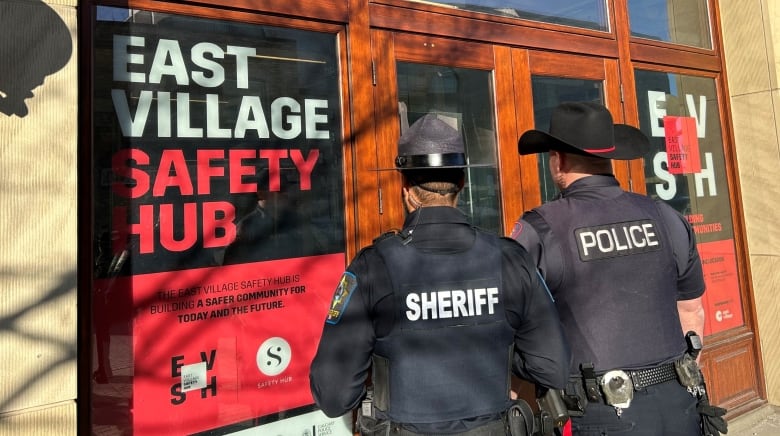On deployment of sheriffs, public safety minister and Calgary police don't seem to be on same page
CPS spokesperson says there is interest in discussing increased use of sheriffs

Sometimes, the things that don't get reported when politicians talk to the media are just as interesting — and illustrative — as the things that do.
At a media conference in Lethbridge earlier this month, in which he announced a new crime-fighting unit for southern Alberta, Public Safety Minister Mike Ellis was asked about a recent spate of shootings in Calgary.
He used the question as an opportunity to talk about sheriffs, and seemed to indicate a difference of opinion between him and the Calgary Police Service when it comes to their use.
"There's enormous investment we've made to support our sheriffs, to augment and support both our RCMP friends as well as the Edmonton Police Service," the minister told the media.
"I certainly wish that the Calgary Police Service would, you know, ask us again for some more assistance. And we're happy to provide them assistance because officer presence matters."
The minister's comments were apparently prompted by the differing ways Alberta's two largest cities responded to provincially funded pilot projects earlier this year that saw sheriffs working in downtown crime hot spots.
In February, the province announced a 15-week pilot project to put 12 sheriffs in Edmonton's downtown core, working with EPS officers to increase patrols.
Two weeks later, a similar 12-week pilot was announced for Calgary, aimed at "improving public safety" in the downtown and Beltline.
No extension in Calgary
At the conclusion of the pilot projects, the Edmonton Police Service and the province agreed to extend the partnership until the end of the year. No such extension was requested by the Calgary Police Service.
When asked by CBC News to expand on the comments made in Lethbridge, the public safety minister's office sent a statement that suggested Calgary's decision not to extend the pilot was behind the minister's words.
"Our offer to CPS and the City of Calgary remains on the table for additional support from Alberta's sheriffs for increased presence on LRT platforms and trains after the pilot project ended," the minister's statement said.
"We know police presence matters, and the sheriffs continue to provide support in high crime areas in Edmonton. Should Calgary look to benefit from this support like Edmonton has, the province is prepared to deploy sheriffs in high crime areas in Calgary."
So why didn't Calgary police decide to extend the program in their city? Why turn down provincially funded sheriffs, essentially free officers at a time of municipal budget pressures?
Supt. Scott Boyd is in charge of community policing in the south division for CPS. He says comparing the pilot project undertaken in Calgary with the one in Edmonton is "difficult" for a number of reasons.
"It's not really apples to apples," Boyd told CBC News.

For one thing, the types of sheriffs used and their levels of training was different.
"All 12 of the Edmonton sheriffs came from the highway patrol … that has the highest degree of clearance and security measures. We got a mix of sheriffs. They came with various backgrounds, from the court system and from highway patrol, and within that group there was a varied level of security clearance, varied level of officer tactics," said Boyd.
That lack of training, security and tactical knowledge meant that the Calgary police officers working in the pilot were responsible for handling most of the work, which wasn't the case in Edmonton.
"I would say that's probably one of the biggest limiters, and certainly not a fair comparison between the Calgary and Edmonton experience," said Boyd.
"We tried to do the best with what we were afforded."
There is also the fact that an impact assessment of the pilot, prepared by the Calgary Police Service, gave the project something less than a ringing endorsement.
"Public respondents noted an increase in uniform presence in the downtown core, but, unfortunately, most reported little change in their overall perception of safety," the assessment's executive summary said.
"The statistical analysis indicates the pilot deployment displaced crime and social disorder within hot-spot locations but had limited statistical impact in the broader deployment zones."
An expected deal
Boyd said that, while the Calgary force decided not to continue with the pilot project, it is continuing to work with the province. He points to the expected deal that will see the province fund 50 new CPS officers by next year as an example.
"These will be Calgary Police Service officers, funded by the province, and they'll be looking to tackle many of the issues that this small pilot between sheriffs and our downtown officers went to tackle," he said.
There is also the news, announced by Ellis last week, that Alberta sheriffs will be providing two new officers to Calgary as members of the city's Safer Communities and Neighbourhoods (SCAN) unit, which works with other law enforcement agencies to shut down properties being used for illegal activities, such as drug trafficking.
Boyd said CPS is interested in discussing an increased use of sheriffs with the province, but for tasks more suitable to their expertise, such as prisoner transport.
"So, the arrests can be made by our officers, but the transport up to our far northwest arrest processing unit could take place by the sheriffs, leaving our officers to remain in place as a visible presence and doing the work that they're best at," he said.
So given the ongoing discussions between Calgary police and the public safety ministry, and given the fact that Ellis was a long-serving CPS officer, what does Boyd think was behind that poke the minister directed at CPS in Lethbridge?
"I'm sure it's a big ministry and he, I know, has a lot on his plate," said Boyd.
"Our latest ask, of where we thought sheriffs could be most effective in Calgary, may not yet have reached him for his consideration."